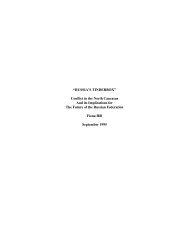Global Environmental Assessment Project - Belfer Center for ...
Global Environmental Assessment Project - Belfer Center for ...
Global Environmental Assessment Project - Belfer Center for ...
Create successful ePaper yourself
Turn your PDF publications into a flip-book with our unique Google optimized e-Paper software.
SEVERE-SUSTAINED DROUGHT ASSESSMENT<br />
Tree-ring data reveal the existence of a drought event in the Colorado Basin that was both longer and<br />
more severe than the critical flow period currently used by the Bureau of Reclamation (Stockton and<br />
Jacoby, 1976; Meko et al., 1995; Tarboton, 1995). 9 How sensitive are water resources in the Colorado<br />
Basin to such an event, and what options are available <strong>for</strong> impact mitigation? To answer these questions,<br />
the Severe-Sustained Drought (SSD) project, composed of academically-based experts in Colorado<br />
River hydrology and policy, tested the capacity of regional reservoirs and the per<strong>for</strong>mance of the Law of<br />
the River under the extreme circumstances of the late 16 th -century drought event.<br />
Using a model of basin hydrology, management facilities and operating rules, the SSD authors<br />
per<strong>for</strong>med a gaming exercise to determine how representatives from Colorado Basin states would<br />
respond to the evolving a 20-year drought event and to the decisions of other participants. While<br />
participants were able to minimize impacts on consumptive uses, non-consumptive uses such as<br />
hydropower generation, recreation, and endangered species were adversely affected (Henderson and<br />
Lord, 1995). For example, at the peak of the simulated drought, Lake Powell emptied and Lake Mead<br />
lowered substantially (Harding et al., 1995), resulting in annual hydropower generating losses of $600<br />
million (Booker, 1995) and the local extinction of multiple fish species (Hardy, 1995). In general , the<br />
Upper Colorado Basin bears a greater drought risk, due primarily to existing compact guidelines which<br />
guarantee the Lower Basin minimum flows. As a result, deliveries <strong>for</strong> consumptive use in the Upper<br />
Basin fell to about half normal levels, whereas they were relatively unaffected in the Lower Basin (Lord<br />
et al., 1995).<br />
To minimize drought impacts, study participants recommended a range of policy options to improve<br />
system resilience to water shortages, such as interstate water transfers and banking, and the creation of<br />
basin-wide commission to coordinate drought response. Basically, the authors argued <strong>for</strong> increased<br />
diversity of inter-state water management techniques - as those outlined under the Law of the River<br />
lacked the flexibility to mitigate drought impacts on a basin-wide basis. Preliminary discussions with<br />
SSD authors indicated that the assessment had little impact on policy or management strategies in the<br />
Colorado Basin. One of the aims of this study was to determine why this was the case - the methods used<br />
to address this question are detailed in the next section.<br />
Methods<br />
Semi-structured, open-ended interviews were per<strong>for</strong>med with key people in the Colorado Basin,<br />
including the principal investigators of the SSD project and members of the SSD Advisory Council (AC)<br />
(Table 2). The AC included representatives from State Engineer's offices, state Departments of Natural<br />
Resources, the Central Basin Water District (Cali<strong>for</strong>nia), the Upper Colorado River Commission, the<br />
Western States Water Council, the Colorado River Board of Cali<strong>for</strong>nia, the Colorado River Water<br />
Conservation District, the Metropolitan Water District of Southern Cali<strong>for</strong>nia, and several academic and<br />
practicing experts in water law. The AC was essentially a "who's who" of inter-state water management<br />
in the Colorado Basin, established to ensure that results of the SSD reached the appropriate stakeholders,<br />
and to provide a venue <strong>for</strong> feedback regarding study design and recommendations. The AC was<br />
established in the late 1980's at the end of the initial SSD scoping stage (Phase 1; Gregg and Getches,<br />
1991), with the intent that comments and suggestions could be incorporated into Phase 2 (Young, 1995),<br />
the funding <strong>for</strong> which began in the early 1990's. Phase 2 was designed to include a more thorough<br />
assessment of environmental impacts and a gaming exercise to simulate the interactive decision-making<br />
process that would occur during an extended drought.<br />
5
















